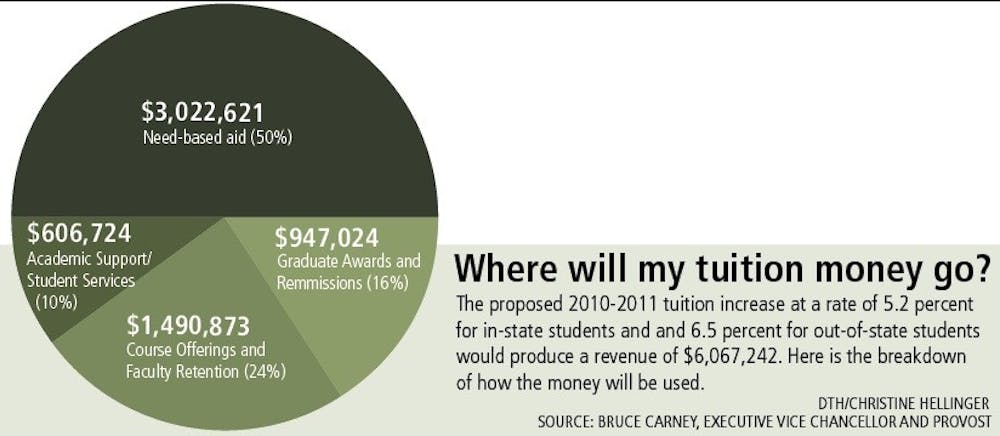Administrators are balancing the desire to keep UNC affordable with the needs of the financial aid office as they determine next year’s out-of-state tuition.
A 23 percent rise in the number of students qualifying for aid this year has forced administrators to increase the percentage of tuition revenue directed toward aid. It stands at 50 percent this year, compared with 40 percent the year before.
That decision will weigh heavily in the final recommendation the tuition and fee advisory task force makes to the chancellor Wednesday.
In-state tuition increases are capped at $200, or 5.2 percent, by the state legislature. Out-of-state increases are not similarly regulated. The task force has suggested increasing nonresident tuition by as much as 6.5 percent — or $1,414.30.
Raising the cost of tuition will generate more money for needy students, which offsets the new need created by the increase, said Shirley Ort, director of the Office of Scholarships and Student Aid.
“We need to make sure that everyone can afford to come here and that access to the University isn’t unduly infringed by the cost of tuition,” said Board of Trustees member Roger Perry.
“But we also need to make sure that the value of your Carolina education is not diminished because of a lack of funds.”
The number of students qualifying for financial aid for the 2009-10 school year rose 23 percent from the previous year, and the Office of Scholarships and Student Aid expects that figure to continue to rise. More students submitted financial aid applications, and more applied on time than in years past.
“It was unlike any other year we’ve ever had,” Ort said.
The school will continue to meet full demonstrated need, but more of that money will come as work study or loans, which must be repaid.
None of the proposed increases will generate enough revenue for the University to provide the same level of grants, which do not have to be repaid, as it has in the past.
While Ort said student need would be less under a smaller tuition increase, putting less of a burden on her office, she wants to make sure she has enough funding to continue covering the majority of student need with aid that does not have to be repaid.
A 6.5 percent increase will come closer to meeting that need, she said, especially as the school faces uncertainty about how much it will receive from outside revenue sources including federal grants and private donations.
“The most important thing for me is that if you charge it, make sure you give me enough money for those students who actually have to pay into that fund so we can protect them from that charge,” Ort said.
In 2007-08, the University was able to cover 70 percent of undergraduate student need with grants and scholarships, up from 54 percent in 1999-2000. The rest was covered with work study and loans.
But even to provide only 65 percent of aid in the form of grants for the coming year, Ort’s office would need $3.8 million, an amount tuition is unlikely to provide. Covering 71 percent in grants would cost $13 million.
Even the larger, 6.5 percent tuition increase for out-of-state students would provide only about $3 million. The smaller increase would generate about $2 million.
The proposed tuition increase for out-of-state students will hit middle-income students the hardest, she said.
These students will most likely not receive aid to cover the increased costs and will have to fund this amount themselves.
Contact the University Editor at udesk@unc.edu.
Financial aid grants might hinge on tuition decision

DTH/Christine Hellinger


